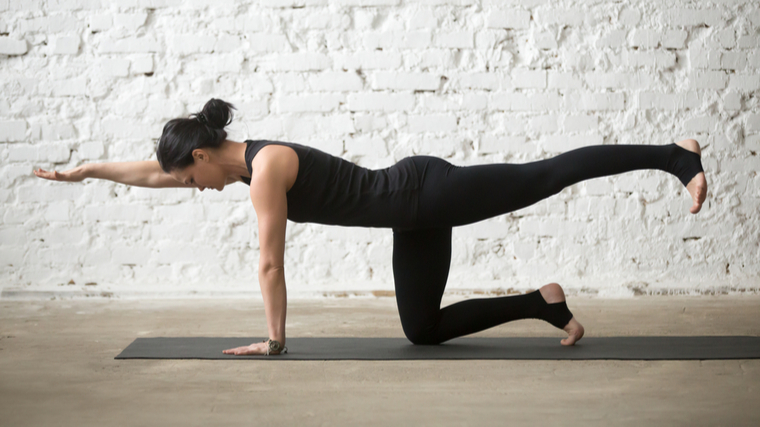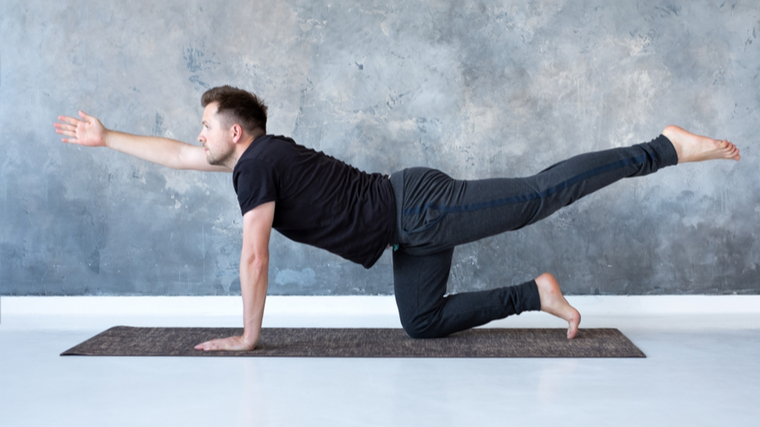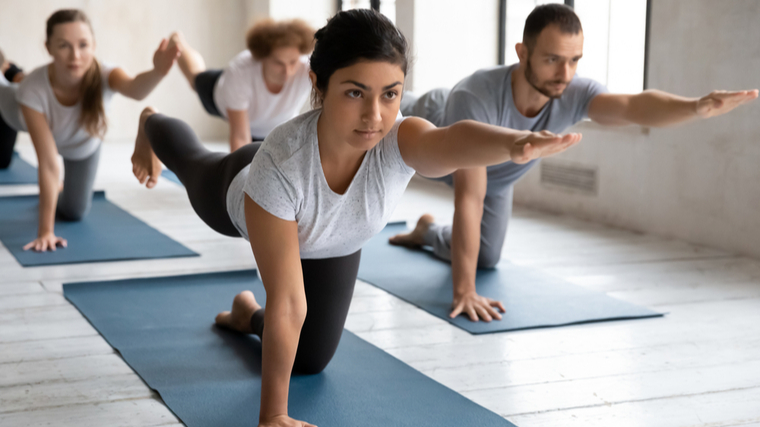Let’s start with a quiz. What’s one exercise that’s often performed poorly, rushed through, or skipped entirely, even though it can help keep your lower back from a world of hurt? If you guessed the bird dog, pass go and collect your $200. The bird dog seems simple to do and might not look like much. But when it comes to your coordination and core stability, the bird dog is a mighty beast.
Years ago, Professor Emeritus of spine biomechanics at the University of Waterloo Dr. Stuart McGill wrote about three exercises to help strengthen the core and prevent lower back pain. The bird dog is one of them (the other two are the side plank and modified curl up, since you were curious).

Dr. McGill asserted that the bird dog improves core stability and strengthens your anterior and posterior core, lower back, and glutes. All of this can spare your lower back a lot of grief. Whether you’re training for improved balance, overall health, or even to strengthen your big barbell lifts, the bird dog is almost as close to a non-negotiable exercise as there is. Here are its major benefits, how to do it, and how to spice up your bird dog training.
Editor’s note: The content on BarBend is meant to be informative in nature, but it shouldn’t take the place of advice and/or supervision from a medical professional. The opinions and articles on this site are not intended for use as diagnosis, prevention, and/or treatment of health problems. Speak with your physician if you have any concerns.
Benefits of the Bird Dog
- Improved Spinal and Core Stability
- Better Hip Extension
- Improved Shoulder Stability
- Better Balance and Coordination
- Potential Injury Prevention
- Versatility
- Unilateral Strength
- Better Core Bracing
Improved Spinal and Core Stability
Spinal stability is your ability to limit your spine’s movement during motion and under load so you don’t damage your spinal cord. When performed well, the bird dog improves spinal stability by stiffening — preventing movement — through your entire core by improving muscular endurance and coordination. Training core stiffness enhances stability and spares your spine unwanted stress while under load.
But wait — there’s more. When your opposite arm and leg are off the ground, a common mistake with the bird dog is to rotate at your hip and lose balance. Perform it correctly and you won’t just keep your balance. You’ll strengthen the anti-rotation muscles of your obliques and further save your lower back from unwanted movement.
Better Hip Extension
It may not feel this way when you have to bend over to pick something up, but the hip hinge is a fundamental movement pattern for a lot of humans. This movement forms the basis of many athletic and activities of daily living.
When you load your hips and hamstrings and not your lower back, you’re protecting your back and moving more efficiently — not to mention growing your glutes. The bird dog gives you stability from the floor, helping you learn to differentiate between hip extension and lower back hyperextension.

If you’re not feeling the bird dog in your glutes and hamstrings, your low back may be slipping into extension. That’s a red flag. If you cannot achieve end-range hip extension with bodyweight exercises like the bird dog, you may have a lot of trouble with bigger moves — think, the deadlift. All the more reason to practice with the bird dog.
Improved Shoulder Stability
The shoulder is a shallow ball and socket joint with an incredible ability to move in multiple directions. All this mobility is great — think throwing a baseball — but your shoulder needs stability, too. Muscles like your deltoids, serratus anterior, rotator cuffs, and the muscles of your upper back work hard to keep your shoulder joint in place and your scapula against your ribcage.
When you’re pressing your non-working hand that’s on the ground, these muscles work isometrically to improve shoulder stability. In turn, this allows you to access even better shoulder mobility for your working arm.
Better Balance and Coordination
Contralateral movement — moving the opposite arm and leg at once — forms the very basis of locomotion. Walking, running, sprinting, and even strength and core exercises have this action as their base. Exercises like the bird dog help you build a better foundation to increase your body’s awareness and move more efficiently.
The best core exercises to improve balance and coordination are contralateral movements like the bird dog. Performing moves like this strengthens the muscles that hold you upright. This move has direct carryover to pretty much all your daily movements and exercises. The better coordinated you are, the more efficient — and therefore, heavier — your lifts can become.
Potential Injury Prevention
The bird dog targets your erector spinae, three long thin muscles that extend from your neck to your lower back. (1) Its main job is to keep your spine neutral under load and during movement. Performing the bird dog regularly teaches your body how to do just that.

The bird dog also provides the time under tension needed for your erector spinae to get stronger and therefore to potentially help prevent injury. The stronger your back, the more resilient it can be under a loaded barbell. While direct lower back training is not a solution for low back injuries, a stronger lower back may help you get better equipped for the general physical stressors of training and daily life.
Versatility
As a bodyweight exercise, you can do the bird dog anywhere, at any time. You can also easily scale it to suit your experience level, goals, and your body’s needs. You can perform it as part of your warm-up or pair it with a strength exercise as a recovery move to prime your core muscles to stay stable.
Unilateral Strength
Bilateral lifts have you lifting with two hands or two feet at once. Because of that stability, you’re able to move max weight in this configuration. Think of your max weight difference between, say, a back squat (bilateral) and a pistol squat (unilateral).
As great as it is, too much bilateral lifting may lead to strength imbalances between sides. If left unchecked, unintentionally pushing or pulling harder with your dominant side may compromise your lifting technique. Enter unilateral exercises like the bird dog. These work to reduce imbalances between sides.

Lifting with the opposite arm and opposite leg also improves oblique strength — the sides of your core — which is important for lower back health and performance in and out of the gym. (2)
Better Core Bracing
Core bracing is the ability to engage your entire core to create the stability you need to lift safely and protect your spine. Front and side planks do a reasonably good job at this, given that they’re isometric core holds. But with those exercises, you’re not moving like you will be when bracing for, say, a squat or deadlift.
The bird dog requires you to brace to keep your spine neutral while moving your limbs. Bird dogs and other dynamic core exercises teach you how bracing feels before approaching the barbell. If you cannot brace with the unloaded bird dog, you might run into some trouble bracing for a loaded barbell squat.
How to Do the Bird Dog
Making sure you’re doing the bird dog correctly requires you to know all the steps of the move. Focus on keeping yourself balanced and performing through one motion at a time.
- Kneel on the floor in a six-point stance (your hand, knees, and toes on the ground). Keep your knees under your hips and your hands directly under your shoulders. Press your hands into the ground.
- Find a neutral spine and keep this the entire time.
- Raise your opposite arm and leg in front and behind you. Keep your core tight and your hips and spine squared.
- Return to the starting position. Perform all the reps on one side or alternate sides.
Rushing through this move won’t help your gains. It’ll actually make the exercise less effective. Take your time and go slowly.
Bird Dog Variations
When you’re looking to improve your core stability, balance, and coordination, here are four bird dog progressions to further strengthen your core and lower back.
Resistance Band Bird Dog
Performing the bird dog with a resistance band increases rotational forces and the demand for core stability. Because the increase in resistance and tension makes it much more difficult to keep your spine neutral, you’ll have to work even harder during this variation.
https://www.youtube.com/watch?v=tjUr9MYbkUA
The band also increases your upper back activation. Just make sure to hook the band securely over your hand and foot — if the band gets loose, it’s going to leave a mark.
Stability Ball Bird Dog
The inherent instability of a stability ball — combined with fewer points of contact on the ground — makes you hyper-aware of any missteps with your form. This encourages you to slow the movement down, resulting in more time under tension for your working muscles.
Your stabilizers will also be firing extra hard to keep your body balanced. This adds an entirely new challenge to an already balance-oriented move.
Quadruped Bird Dog on Bench
Narrowing your base of support combined with the padded weight bench makes the regular bird dog that much harder. Here, you will receive instant feedback about your form. Any hip rotation or hyperextension of your lower back will give you that precarious sensation of nearly toppling off of a bench.
To avoid this, you’ll move a lot slower. Going slower means you’re giving your lower back, hamstrings, shoulders, and glutes a lot more time under tension. That’s great for building muscle and strength.
Close-Base Bird Dog on Bench
This move is a progression from the quadruped bird dog on a bench. You’ll be performing the same movement, but with an even narrower base of support. This means that it will be even harder to balance — thus, the challenge to your core will be that much more intense.
You’ll be working harder to resist increased instability and rotational forces. As such, you’ll really need to lock in your focus if you want to keep your spine neutral.
Bird Dog Form Tips
There are three big no-no’s when it comes to performing the bird dog. First, avoid any hip or low back rotation. Doing so negates the core strength and stability benefits of this move. Second, try not to arch your lower back to give yourself more hip extension. This will also sabotage your spinal stability benefits and might even risk hurting your lower back. Last but not least, letting your tension slip and rushing through this sloppily will result in a potentially embarrassing loss of balance.

[Read More: Best Lower Back Exercises for Strength and Reduced Pain]
To help you keep a neutral spine and squared hips, try putting a small weight plate or a yoga block on your back. Find a neutral spine and have yourself or a partner put a light weight plate or a block on the base of your spine. Arch your lower back and the weight plate will slip off. Rotate, and the weight plate falls off. Lose tension, and… well, you get the picture.
Programming the Bird Dog
The bird dog isn’t about lifting heavy weight, but that doesn’t mean it doesn’t deserve a glamorous place in your program. You can program the bird dog into your dynamic warm-up or use it as a recovery exercise supersetted with big strength moves.
If you’re going to use it as a warm-up exercise, complete one or two sets of 10 slow, deliberate reps on both sides. Alternatively, incorporate this move into a superset with a strength-focused compound lift that requires core, shoulder stability, and hip mobility. The bird dog can help your muscles stay activated and ready between sets. Doing so would look like the following:
- 1A. Deadlift OR Squat: three to five reps
- 1B. Bird Dog: 10 reps per side
Your rest period when you’re lifting that heavy will likely last longer than the bird dog reps will require. This way, your body will have time to recover and stay ready for more.
Bird Dog or Bust
There are a ton of fancy core exercises, but you might have a hard time finding a bodyweight move as simple and effective as the bird dog. With its benefits for core stability, lower back strength, and anti-rotation prowess, the bird dog is the total package.
Doing it as part of your warm-up or as a recovery drill after a strength exercise will improve your movement and coordination. It can even help prevent lower back injuries. Adding bird dogs to your routine will majorly strengthen your lower back and take your balance and core stability to the next level.
References
- Joaquín Calatayud, Adrian Escriche-Escuder, Carlos Cruz-Montecinos, Lars L Andersen, Sofía Pérez-Alenda, Ramón Aiguadé, José Casaña Tolerability and Muscle Activity of Core Muscle Exercises in Chronic Low-back Pain. Int J Environ Res Public Health. 2019 Sep 20;16(19):3509.
- María Pilar García-Vaquero, Janice M Moreside, Evaristo Brontons-Gil, Noelia Peco-González, Francisco J Vera-Garcia. Trunk muscle activation during stabilization exercises with single and double leg support. J Electromyogr Kinesiol.2012 Jun;22(3):398-406.
Featured Image: fizkes / Shutterstock